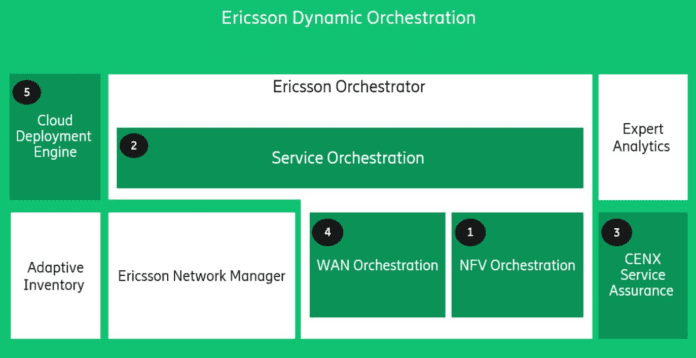Orchestration solution includes automation, assurance tools from CENX acquisition
With limited 5G deployments commercially available in some key global markets right now and operators set to quickly scale out coverage, the early focus is on enhanced broadband, both fixed wireless and mobile, with revenue not expected until the 2020 timeframe. As the technology continues to mature and carriers refine enterprise- and industrial-facing offerings–likely a combination of internet of things implementations and the higher capacity/lower latency of 5G, network orchestration and automation will quickly become either a pain point or differentiator on the way to 5G profitability.
Citing internal research, Ericsson’s Michael Martinsson, director of OSS and BSS marketing, wrote in a recent blog post that telco networks will have to keep pace with a 5x increase in data traffic in 2024. Facing that reality, “Operators need to deploy a new kind of infrastructure that can efficiently manage these factors—in a way that also future-proofs the network for technology that is yet to come.”
Some of the primary buzzwords associated with 5G are cloud-native, distributed computing and network slicing–easy to type, hard to do. As these next-generation networks are built and refined, operators are taking a more IT-centric approach and investing in distributed and centralized computing infrastructure to put workloads where they need to be to take advantage of massive latency reductions and serve mission critical applications like precision industrial control or autonomous vehicles. And, in the long term, all of this will take place on a wholly virtualized network wherein logical network slices are automatically spun up on demand in a manner that makes the most efficient use of spectral and network resources while exactly meeting the demands of the application.
Martinsson called network slicing “one of the biggest opportunities in 5G…[But] because a slice will perform as a dedicated network, more slices mean increased complexity. This will be impossible to profitably manage without orchestration capabilities.”
The Swedish network vendor’s cut at solving this problem is called Ericsson Dynamic Orchestration; it covers inventory, network testing, domain management, service assurance and analytics. The solution also incorporates technologies that came with the 2018 acquisition of CENX, a U.S. company that specialized in cloud-based closed-loop automation and assurance.
Ahead of Mobile World Congress Barcelona last month, Ericsson highlighted enhancements to Dynamic Orchestration: cloud-native NFV orchestration; a service orchestration module that can be deployed in central, edge or private data centers; the aforementioned CENX functionality; WAN orchestration for the transport network; and automated testing for cloud services.
OK, so what does all that mean? Martinsson wrote that the goal is to make the transition to 5G, as well as the ongoing evolution of it, as easy as possible. “We believe that when it comes to orchestration, this is the solution to tackle those hefty forecasts and open up new opportunities for the technology that’s here today and the challenges that are yet to come.”

